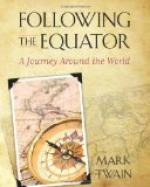The population of Australasia—4,000,000—sinks into nothingness, and is lost from sight in that British ocean of 400,000,000. Yet the statistics indicate that it rises again and shows up very conspicuously when its share of the Empire’s commerce is the matter under consideration. The value of England’s annual exports and imports is stated at three billions of dollars,—[New South Wales Blue Book.]—and it is claimed that more than one-tenth of this great aggregate is represented by Australasia’s exports to England and imports from England. In addition to this, Australasia does a trade with countries other than England, amounting to a hundred million dollars a year, and a domestic intercolonial trade amounting to a hundred and fifty millions.
In round numbers the 4,000,000 buy and sell about $600,000,000 worth of goods a year. It is claimed that about half of this represents commodities of Australasian production. The products exported annually by India are worth a trifle over $500,000,000. Now, here are some faith-straining figures:
Indian production (300,000,000 population), $500,000,000.
Australasian production (4,000,000 population), $300,000,000.
That is to say, the product of the individual Indian, annually (for export some whither), is worth $1.15; that of the individual Australasian (for export some whither), $75! Or, to put it in another way, the Indian family of man and wife and three children sends away an annual result worth $8.75, while the Australasian family sends away $375 worth.
There are trustworthy statistics furnished by Sir Richard Temple and others, which show that the individual Indian’s whole annual product, both for export and home use, is worth in gold only $7.50; or, $37.50 for the family-aggregate. Ciphered out on a like ratio of multiplication, the Australasian family’s aggregate production would be nearly $1,600. Truly, nothing is so astonishing as figures, if they once get started.
We left Melbourne by rail for Adelaide, the capital of the vast Province of South Australia—a seventeen-hour excursion. On the train we found several Sydney friends; among them a Judge who was going out on circuit, and was going to hold court at Broken Hill, where the celebrated silver mine is. It seemed a curious road to take to get to that region. Broken Hill is close to the western border of New South Wales, and Sydney is on the eastern border. A fairly straight line, 700 miles long, drawn westward from Sydney, would strike Broken Hill, just as a somewhat shorter one drawn west from Boston would strike Buffalo. The way the Judge was traveling would carry him over 2,000 miles by rail, he said; southwest from Sydney down to Melbourne, then northward up to Adelaide, then a cant back northeastward and over the border into New South Wales once more—to Broken Hill. It was like going from Boston southwest to Richmond, Virginia, then northwest up to Erie, Pennsylvania, then a cant back northeast and over the border—to Buffalo, New York.




